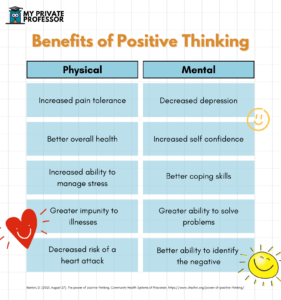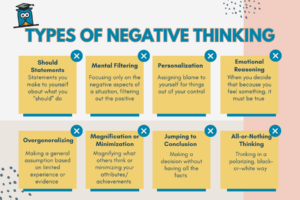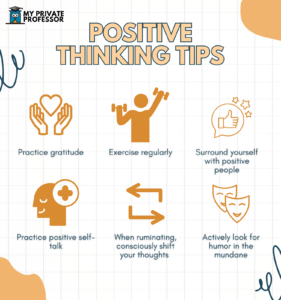Our world is made up of uncertainty. And that’s ironically one of the few things of which we can be certain!
As a result of this lack of certainty, we subconsciously construct our own realities. And we do this by getting in the driver’s seat and taking agency over our mindset.
Imagine that your commute to volleyball practice takes twice as long as it does normally, because of an accident. During this time, you might sit, fuming about how much this added time is costing you. Or, you might sit peacefully, as you’ve realized that this extra time gives you the perfect opportunity to practice mindfulness (which you keep trying to do but just can’t seem to find the time).
The result is that, if you follow option one (fuming), it might be difficult to transition out of your angry mindset and into a headspace that allows you to focus on your volleyball. But if you focus on the positive side, on what all of this time allows you to do, you’ll find it a lot easier to get your game face on.
The truth is that each and every one of us could think of a hundred different ways on how positive thinking may help us. For the purpose of this article, we’re going to look at how students can benefit majorly from positive thinking.
The science behind positive thinking
Positive thinking reduces stress
It can understandably be difficult to wrap your head around the fact that positive thinking can majorly change your life. It seems so incredibly simple, yet also like a vague phenomenon.
Understanding what actually occurs in the brain during positive thinking, then, can be a helpful way to get more clarity about why you should be making this change in your life.
So here it is.
Positivity is related to a release of the “feel-good” hormones, serotonin and dopamine. Meanwhile, thinking positive thoughts also leads your brain to reduce the amount of cortisol (the stress hormone) that it’s producing.
The result is many-fold. Improved memory, more effective learning, and better problem solving. 
Generally, positive emotions, researchers have found, can reduce stress and improve overall well-being—which brings me to my next point.
Positive thinking boosts productivity
You’re more productive when you feel more positive? Yeah, this one shouldn’t surprise us at all.
We’ve all been there. We’re going through something tough, yet we’re expected to be a person. Let alone a productive person! As you probably know, this can be insanely difficult.
But on the contrary, when you feel great, you’re probably much more productive, right?
Indeed, in one study, researchers at Stanford University School of Medicine found that among 240 children, being positive about their studies led to increased productivity and academic achievement.
Maybe this is due to how positive thinking boosts motivation? And creativity? And concentration? Sounds about right.
The researchers also observed brain activity from forty-seven students. Ultimately, they wanted to look at the effects of attitude on achievement. The researchers found that the hippocampus (which is associated with memory and learning) was significantly more active in kids with a positive attitude about their studies (regardless of skill level) than in kids with a negative attitude.
Then, they were able to determine that a student’s attitude about their learning can impact academic achievement about as much as their IQ.
In her research on over 3,000 individuals in seventy-nine countries, Jessica Pryce-Jones found that happiness does indeed impact productivity. Specifically, she found that participants who were happier were 180% more energized at work, 107% more engaged, fifty percent more motivated, and fifty percent more productive.
Psychology professor Barbara Frederickson, in her “broaden-and-build” research, found that participants who watched positive videos were more engaged and motivated than those who viewed neutral or sad videos.
Positive thinking promotes resilience
With any educational journey comes challenges and roadblocks. That’s a give in. And while the challenges that come any student’s way can impact their educational outcomes, their response to these difficulties is the important thing to focus on.
And that’s because the reaction to a challenge is what students can manage, whereas the challenges are inevitable.
When students have a growth mindset, they develop an important skill: taking challenges as opportunities to grow. As a result, these students are more able to conquer their academic fears and challenges, and reach their potential.
Why is it so difficult to practice positive thinking?
Have you ever been in a tough situation and received advice like, “Just think of all the positives!” or, “Look on the bright side…” In this scenario, was it pretty easy to simply do as you’re told and focus on the positives? For many of us, it seems, it’s much easier said than done.
We tend to have trouble switching from a negative state of mind to a positive one—and this can mean that we harp on the negatives, which can impact our mental health, our productivity, and our relationships.
Weirdly, we are much more capable of switching from a positive mindset to a negative one than vice versa. In psychology, this is called the negativity bias. Essentially, this just refers to our tendency to engage with negative information/thoughts more often than positive ones.
It seems, as humans, our brains are somewhat hardwired to focus more energy on the negative than the positive.
In fact, our amygdala and limbic system are literally programmed to identify threats in order to protect us from danger.
Perhaps this was, at some point, super beneficial (evolutional) as it helped us avoid danger. But for a lot of us, we’re no longer living in constant fear of predators chasing us at night.
What’s the problem with negative thinking?
According to the American Psychiatry Association, if you’re in a depressed mood and you ruminate (repetitively dwell on negative events/thoughts), you’re more likely to remember more negative events that’ve happened in the past, you’ll interpret situations in your current life more negatively, and you’ll feel despondent about the future.
And this can seep into your life in various ways. For instance, you might withdraw from social events you’d otherwise attend; or you might project your feelings onto your friends; or maybe, you’ll be incredibly distracted during important lessons at school.
Essentially, it’s clear that negative thinking can hinder almost every aspect of your life. Which is why it’s crucial to develop the necessary tools to effectively be able to practice positive thinking.
How to foster positive thinking in the classroom
Hold mindfulness sessions
When I was a student, my biology teacher would have us sit for a “mindful minutes” session before each class. At the time, I (and a lot of other students) didn’t really understand the purpose of this.
Maybe that’s simply because I never tried to really give it a chance. So I didn’t get to see the impact of mindfulness firsthand.
But after practicing different forms of mindfulness over the years, I finally get it.
Not only can having mindfulness sessions benefit students, but they also support teachers. And in the classroom, when both the students and teacher feel aligned in their positive energy, it makes for a much better classroom space.
Research has actually shown that those who use meditation to reflect have more positive reactions daily than those who don’t meditate regularly.
Obviously you can’t master mindfulness overnight. But once you start getting the hang of it, you’ll likely notice that you’re feeling less on edge and more present.
Teach students how to practice positive affirmations
The cool thing about our brains is that we really can, to some extent, take control. I mean, of course you can’t go and tell your brain to tell you what your boyfriend’s thinking, but you can change the course of your thoughts.
By regularly taking the time to do positive affirmations, you’ll be training your brain to become a pro at positive thinking.
And research confirms this! For example, a study conducted by researchers at James Cook University in Australia found that self-affirmations positively impact coping skills and well-being.
You can also directly present students with the opportunity to spread positivity to their classmates. When I was in third or fourth grade, one of my teachers had us do an activity (I think it was on Valentine’s Day) where we made notecards for every student. On the cards, we talked about simply what we liked or admired about each kid.
Though it seems like a simple activity, the resulting positive energy can turn a kid’s entire day around.
Provide students with sufficient outdoors time
For some reason, we are very drawn to nature. And you always hear doctors and various “experts” talking about the benefits of spending time outdoors. Reportedly, spending time outdoors is linked to increased mental wellness and focus.
Research has also suggested that those with more of a “connection” to nature have more positive emotions than those who have less of a connection.
In one study, participants either watched a few minutes of the documentary Planet Earth, a “neutral” video from a news show, or humorous footage from Walk on the Wild Side. The researchers found that those who watched Planet Earth felt forty-six percent more in “awe” and thirty-one percent more gratitude than those in the other groups.
In another study, researchers found that those who lived near larger areas of green space were less stressed and had greater declines in cortisol levels throughout the day (i.e., more stress reduction).
There’s even something called the biophilia hypothesis, which suggests that for some evolutionary reasons, we seek out experiences in nature. And that we may prefer these environments due to their being replete with resources (food, shelter, comfort).
Teach students about breathing techniques
One incredibly simple way to promote feelings of positivity is to practice breathing exercises. According to research, the brain actually associates different emotions with different breathing patterns—so essentially, you can trick your brain into producing more positive emotions. Cool, right?
Also, slow breathing practices not only help your emotional well-being, but can improve your physiological state. (And this can indirectly also support emotional well-being!)
By regulating key physiological processes (i.e., heart rate, blood pressure), slow breathing exercises can help students shift out of the fight-or-flight mode and into a more relaxed state, according to a meta-analysis.
Like any new exercise, developing a regular routine with breathing exercises can be difficult. Teachers can thus help students by getting started with a breathwork routine in the classroom.
And you don’t need a lot of time! One study found that just five minutes of breathwork daily for around a month could improve mood and reduce anxiety.
Engage students in gratitude activities
Through its way of promoting positive thinking, practicing gratitude can benefit students in the classroom and beyond.
While practicing gratitude and positive thinking are two different things, they are also, undoubtedly, connected. Really, practicing gratitude is a form of positive thinking. So by developing a gratitude-friendly mindset, students can form the foundations for positive thinking.
In general, research finds that having a gratitude mindset can improve students’ mental health and wellness. And as you may know, mental wellness is directly related to learning outcomes. In fact, one report found that mental health is one of the strongest predictors of academic performance.
By practicing gratitude, students over-time can lower their stress and also boost their happiness, satisfaction, and well-being, according to research.
In the classroom, teachers can offer students opportunities to develop their gratitude practice through activities such as journaling sessions, where students write about what they’re grateful for.
Final thoughts
It’s simple: have positive thoughts, and then you can spread positivity. You can put it into the work you do in school; you can put it into your friends; and you can put it into your creative projects.
Even though we have the tendency to focus on the negative, we’re not built to withstand prolonged periods of negative thinking. As it seems, every single person has this outstanding goal of achieving happiness.
We nourish our physical health by exercising and eating right. Engaging in positive thinking is like drinking a thick green, antioxidant-full smoothie—but for the mind and soul.







